Bridging a WOPL 400 would get you 1600, yes. But it wouldn't live. You could only drive an 8 ohm load. The Macs get by with driving a 4 olm load due to it's output transformer. Distortion in a quasi would also double or quadruple. It's a very dirty way to to get more power. Bob Carver tried it in the beginning, in fact there were 4 bridge amps manufactured (not sure on the number) when the outputs only totaled 4 per row like the 400's. They went to 6 per row after serial #5 IIRC. Very unreliable.
Ok, gotcha. So your also saying 400s can't be used as mono blocs right or can you? I thought when you bridge an amp, your just combining the two channels into one mono signal. So how far am I off with that theory? I was hoping I could run both WOPL's as monoblocs but that seems to not be possible then. I can still use one amp for each speaker though by going off the left channel + and the right channel - right? I am lost again because that make it a monobloc though right? Time for some schooling for me Lee
I found this online
Basically, one channel's signal is inverted, and then the two channels are combined to form one channel with twice the voltage of either of the original channels.
Ohm's Law for Alternating Current states that I = V/Z where I is current, V is voltage, and Z is impedance. We also know that P = IV, where P is power. If we use Ohm's Law and substitute into the power equation, we get P = V(V/Z), which can be rewritten as P = (V^2)/Z. Therefore, power is the square of voltage divided by impedance.
Now, why do we care about all that? Because it explains precisely what happens when an amp is bridged. I'll give a practical example and explain the theoretical basis of that example.
Imagine you have a two-channel amp that puts out 50 watts into each channel when driven into a load of 4 ohms per channel. Since we know P and Z, we can plug these numbers back into our power equation and find V. 50 = V^2/4 -> V = sqrt(200). So, we're seeing a voltage of 14.1 volts across each channel.
Now, imagine we bridge this amp, and use it to push just one of those 4 ohms loads. When the amp is bridged, the voltage is doubled. Since we know the voltage (2*14.1 volts), and the impedance (4 ohms), we can calculate power. Remember that P = V*V/Z. That means P = (28.2)^2/4, which is 198.1 watts. It should be clear by now that the new power is approximately 200 watts - quadruple the power of a single, unbridged channel!
You can probably see that should be the case, especially if you look back at the power equation. Since P = V*V/Z, if you double V, you quadruple power, since V is squared in the power equation.
Now, all this assumes the amp is stable into 4 ohms mono. The mono channel is putting out four times as much power as a single unbridged channel, so it must be putting out twice as much as the two single channels combined. Since the voltage on the supply side of the amp is dependent on the car's electrical system, it doesn't change (OK, the increased current might cause a voltage *drop*, but let's not worry about that now). Looking at the first power equation, at the supply side of the amp, we see P = IV. Now, when we bridged the amp, we doubled the power, but the input voltage stayed the same. So, if we hold V constant, the only way to double the power is to double the current
I also understand that impedence is only a speaker thing now. I just wonder why there is 4ohm specific amps then


